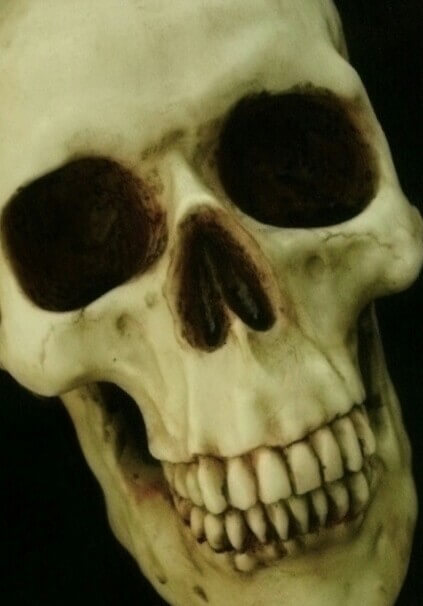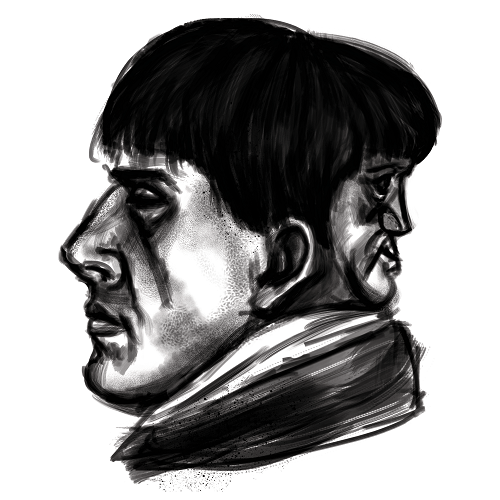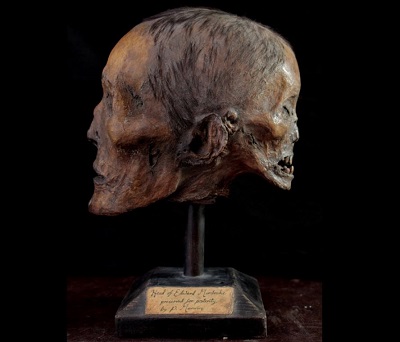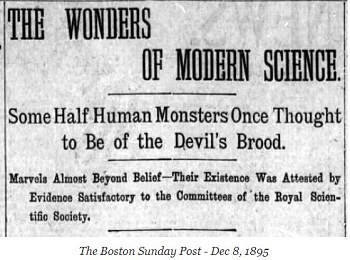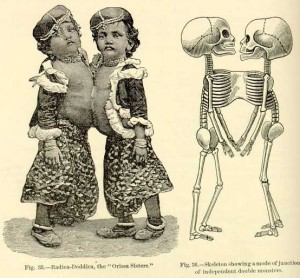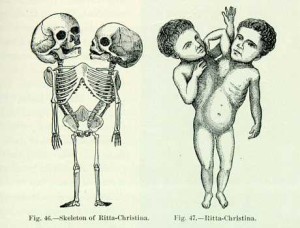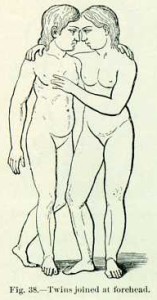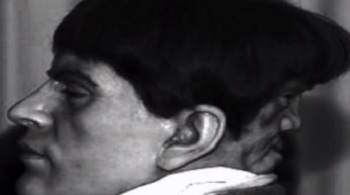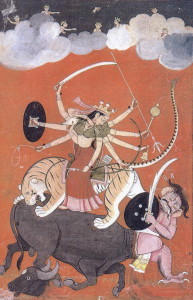This is the dubious story of Mr. Edward Mordrake (also spelled Edward Mordake). Perhaps this one is the strangest story of all deformities in human history.
Article updated by Trina McMillin.
If This Is Mordrake’s Mummified Head, It Would Surely Prove His Existence
Mordrake, who was a wealthy man from the 1800s, is said to have had the face of his evil twin attached to the back of his head. There has been continued debate as to whether Mordrake was a real man or just a product of fiction writer Charles Hildreth’s imagination; although this debate seemed to have cooled, on April 30, 2018, a Facebook page, Pictures in History, came forward claiming to have a picture of Mordrake’s mummified head, with the evil twin’s face fully intact.
While the Facebook page does display a picture of Mordrake’s severed head, with the evil twin intact, this is a picture of what is referred to as a ‘gaff.’ A gaff is an art piece used by sideshow attractions to trick the viewer into believing that something actually exists. This, according to Ewart Schindler, the artist responsible for creating the Mordrake gaff.
Schindler states that he created the piece several years ago, but it just recently gained popularity. During an interview with Newsweek, Schindler said that he was surprised that no one had created a gaff of Mordrake, with him being such a popular legend. Needless to say, the picture of Mordrake’s wax head does not prove his existence.
The Earliest Reference Of Mordrake
Charles Lotin Hildreth was a fiction writer who wrote the first known description of Mordrake. It was a 1895 article from Boston Post.
In 1896, Mordrake’s story was recognized in “Anomalies and Curiosities of Medicine,” which was considered a mostly legitimate medical book. The documentation of his story in this prestigious book is what led to an increase in the number of people who believed Mordrake and his evil twin truly existed: For the most part, this belief continued for over a century.
Fact or Fiction: The Debate
In 2015, The Museum of Hoaxes began investigating the Edward Mordrake story. One of the website’s historians sifted through old, archived newspapers to find information related to Mordrake. The researcher found the initial Dec. 8,1895, story that was written by Hildreth in The Boston Sunday Post, which was identical to the one the medical book published the following year; however, no evidence was ever found to verify the human anomalies Hildreth had written about in the article were actually based on real people.
Besides Mordrake, there were many other human freaks in the 1895 article. Examples include a woman who was described as having the tail of a fish, a man who had the body of a spider, and a man who was supposedly half-crab. However, these cases were not genuine. Plus, being a fiction writer, the article by Hildreth doesn’t make the case for Mordrake’s existence at all convincing.
The Evidence, or Lack Thereof
Despite the unsuspecting reception many people have given this story, there are quite a few reasons for skepticism.
Reasons to be skeptical include:
- There is not even a date of birth, nor the date of his death documented. Although his case was said to have occurred in the 1800s, one would think that there would be at least some good evidence to confirm the claim of his existence. So basically, all researchers can rely on are a couple of references, and stories that were passed down from generation to generation.
- According to some versions of the story, the second face was a beautiful woman. However, this is a false claim. The reason that Mordrake’s twin cannot be a female is because in all cases of craniopagus parasiticus, the pair is identical. Therefore, they are of the same sex.
- There is very little scientific verbiage used throughout the Mordrake entry, yet there is a high-degree of melodrama, in relation to the acts of his ‘devil twin’ that is: In fact, the only ‘scientific verbiage’ included in this entry is the now obsolete medical classification term ‘bicephalic monsters.’
- Other entries within the medical book are based on medical case histories (e.g., the life of Joseph Merrick, aka the ‘Elephant Man’).
- In The Theosophical Review, 1906 edition, Mordrake’s two attending physicians, Manvers and Treadwell, who were both cited in the medical book, were not listed in the Dictionary of National Biography (DNB). The DNB is a Victorian-era book of notable figures from British history.
- According to the “Anomalies and Curiosities of Medicine” authors, Gould and Pyle, the passage about Mordrake was quoted from lay sources or, in reality, a lay source – the Dec. 8, 1895, syndicated newspaper article in The Boston Sunday Post written by Hildreth. The content in the medical book is identical, word-for-word, to Hildreth’s article. Science historian Alex Boese discovered this evidence.
According to Boese, each of the human anomalies detailed by Hildreth in his 1895 article had something in common, none had been mentioned in any previous sources. Therefore, it seems that Hildreth had created these individuals and while his article may have initially been considered nonfiction, it should actually be characterized as theoretical fiction. In the end, Boese concludes that Edward Mordrake is nothing more than the literary creation of Charles Lotin Hildreth, a poet and fiction author at The Boston Sunday Post.
Anomalies and Curiosities of Medicine
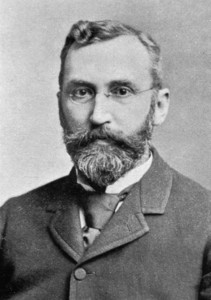
However, despite the lack of a medical diagnosis, what makes their mention of Mordrake seem credible is that their work was non-fiction. So did they make an exception to include fiction in this particular article? Perhaps they believed that despite Hildreth being a fiction writer, for some reason, the case of Mordrake was genuine.
To read the entire account (verbatim) on Mordrake from the Anomalies and Curiosities of Medicine medical encyclopedia, visit Wikipedia.
Below are portraits of people with rare medical conditions from the 1896 Anomalies and Curiosities of Medicine encyclopedia.
A Photograph Of Mordrake
The photograph above is not an actual picture of Mordrake, nor his “devil twin.” It is just one of various wax sculptures that artists had created some time after his death. If you go to Google Images and type in “Edward Mordrake,” what you get is a variety of photographs that are solely wax replicas displayed in various museums around the world.
The wax interpretation was created for curious spectators who want to get a good idea of what this incredibly freaky man might have looked like (if he ever existed). Interestingly, not a single genuine photo of Mordrake exists. The jury’s still out on whether the genuine photos got lost, or never even existed in the first place.
The following information is based on claims of Mordrake’s medical condition and alleged suicide.
Mordrake’s Bizarre Medical Condition
Based on Mordrake’s appearance from various wax sculptures, if he existed, he likely had a form of one of these rare medical conditions. The three are listed below:
1. Craniopagus Parasiticus: An extremely rare medical condition in which the head of a parasitic twin is attached to the head of the twin which is usually more normal.
2. Diprosopus: A conjoined twin with two faces.
3. An extreme form of parasitic twin: A twin who is a smaller and undeveloped member of a pair of unequal conjoined twins.
Below are characteristics of the duplicate face that he called “demon face.”
Characteristics Of Mordrake’s Duplicate Face
The face was unable to eat or speak out loud.
When Mordrake was happy, the face would smile.
When Mordrake would cry, the face would smirk.
The face would never sleep. Instead, it was nothing but a complete nuisance.
According to Mordrake, due to evil whispers from his duplicate face during the night, he had a hard time getting sleep.
Mordrake Decides To End His Life
Throughout Mordrake’s life, he secluded himself from the world. After all, who could blame him? Due to all of his unwanted discomfort, annoyance, and lack of a normal life, Mordrake begged doctors to remove his “evil demon face.” Unfortunately, physicians refused to have it surgically removed. Sadly, Mordrake’s life came to an end at the age of just 23.
It was the irritating and “evil twin” that drove the nineteenth-century Englishman to commit suicide. Before committing suicide, Mordrake left instructions requesting to have his duplicate face obliterated before his burial. The reason he wanted the face eliminated, is simply because he wanted to prevent it from continuing its wicked whispers in his grave.
Mordrake In The Media
- Mordrake was featured in the 1976 edition of The Book of Lists. The list is called “10 People With Extra Limbs or Digits.”
- American singer-songwriter and actor Thomas Alan Waits wrote a song about Mordrake for his 2002 album called Alice. The song is called “Poor Edward.”
- So far, there have been three episodes on Mordrake in the popular series American Horror Story: Freak Show. The character is played by American actor Wes Bentley.
- Since April of 2014, a US thriller film has been in development. The film is based on a true story and is called Edward Mordrake.
A Case Somewhat Similar To Mordrake
In the early 1980s, a man named Chang Tzu Ping had a bizarre deformity that was perhaps the closest to Mordrake. However, unlike Mordrake, this case was actually documented. Ping was a Chinese man who also had a second face. Although the extra face was incomplete, it did have a mouth, a few teeth, a patch of scalp, and even a tongue that was malformed.
Unlike Mordrake, Ping was able to get his second face surgically removed. The successful operation gave Ping a normal face, which allowed him to move on and live a normal life.
More Reasons To Believe The Story Of Edward Mordrake Is False
Below are a couple of YouTube videos regarding babies who have two faces.
Of course, there are major differences between them and Mordrake. One is that unlike Mordrake, their extra face is not located on opposite sides. The second major difference is that Mordrake supposedly lived to the age of 23.
If he really had a form of diprosopus or craniopagus parasiticus, he probably wouldn’t have lived that long. There have only be around 35 cases where infants with diprosopus have actually survived well past birth. Also, individuals who have craniopagus parasiticus, rarely survive past birth.
2 Cases Of Babies With Two Faces
In 2014, An Australian couple was unaware that the twins they were expecting would be born with a rare medical condition called diprosopus. The twins were born with two symmetrical faces and two brains that are connected by one brain stem. As you can see, unlike Edward Mordrake, their faces are not on located on opposite sides. Although the majority of babies with this condition will die shortly after their birth, conjoined twins Faith and Hope have defied the odds. They lived for nearly three weeks. Before their death, the two miracle girls had developed distinct personalities.
In 2008, a girl named Lali Singh was born in a north Indian village. Like conjoined twins Faith and Hope, Lali is one of the very few infants with diprosopus to survive well past birth. Lali was born with two noses, two pairs of eyes, and two mouths. However, she only had one pair of ears.
Interestingly, according to an article on Wikipedia.org, Lali might have been the only known living individual with complete facial duplication. Despite all odds, this miracle baby lived to be two months old. Sadly, she died of a heart attack. Before Lali’s death, she was worshiped as a goddess and was seen as the reincarnation of the Hindu goddess named Durga (portrait below).
Durga The Hindu goddess
Conclusion
If this story is actually true, it is likely one of the strangest medical cases in all of human history. However, even if it is just another myth, the character in the story has already been the subject of various plays, songs, television shows, and even a U.S. thriller film. Perhaps, in a horror film, Edward Mordrake would make an excellent evil murder suspect with a split personality disorder.
